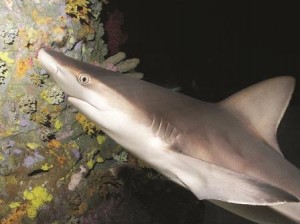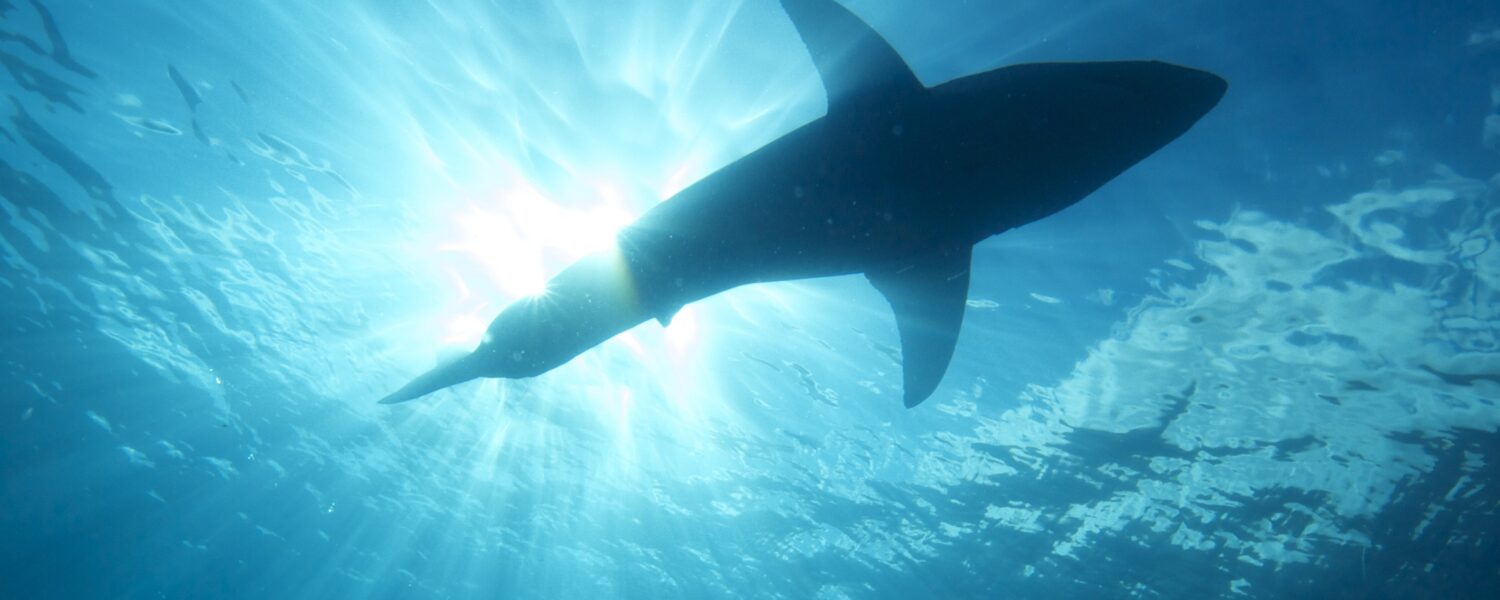By Chuck Bangley
The sounds, estuaries and ocean waters in and around North Carolina provide a variety of habitats for water-dwelling species, including an abundance of sharks. Here is a quick look at some sharks that are commonly found in the state.
SHARKS IN THE SOUNDS
Most sharks found in North Carolina’s sounds and estuaries are transient, making a quick trip into the estuary to feed or migrate through. However, some will use the sounds as nursery habitat and their young may stay for months. Here are some species regularly encountered in the sounds.
• Atlantic sharpnose sharks (Rhizoprionodon terraenovae) are among the most common in North Carolina waters. The adults can reach 4 feet in length and are found both in estuarine and oceanic waters, usually during the summer and autumn. Sharpnose sharks use Core Sound and other sounds to the south as nurseries. Their foot-long pups can be very common in these areas, often caught by recreational fishermen looking for puppy drum and Spanish mackerel. Adults generally are greenish-grey with white spots, while pups usually are lighter colored.

Visitors can stay on dry ground and still see a variety of sharks at the N.C. Aquariums, such as this sand tiger shark. Photo by Scott Taylor for N.C. Aquariums.
• Blacktip sharks (Carcharhinus limbatus) are among the larger sharks in the sounds, reaching lengths of 8 feet, although most measure 6 feet or less. They occur in ocean waters from late spring to late fall, and usually move into the sounds during the summer and autumn. These fast predators chase schools of menhaden and mullet, and will sometimes make spinning leaps out of the water while feeding. Recreational fishermen target these sharks for the strong fight they can put up when hooked. Blacktip sharks have black margins on every fin but the anal fin. The leading edge of their dorsal fin starts just above or slightly before the trailing edge of the pectoral fins.
• Bonnethead sharks (Sphyrna tiburo) are small members of the hammerhead shark family, with adults reaching a maximum length of 5 feet. They occasionally occur in the southern reaches of Pamlico Sound and become common from Core Sound south, as well as close to the beach on the ocean side of the barrier islands. Bonnetheads primarily feed on crustaceans, especially blue crabs, and can be seen sweeping their heads across the bottom to detect electrical signals given off by buried prey. These sharks have smaller, more rounded “hammers” than other hammerhead species.
• Bull sharks (Carcharhinus leucas), which can top off at 10.5 feet, are the apex predators of the North Carolina sounds. They can tolerate brackish and fresh water, and for that reason can be found in nearly any body of water that has a connection to the ocean. Adults and juveniles have been sighted in the Newport, Neuse and Pamlico rivers, and even parts of the Albemarle Sound. Bull sharks attack large prey, as evidenced by bite scars on resident bottlenose dolphins in the Neuse River and reports of large red drum eaten off fishermen’s hooks. This species can be dangerous to humans and should be treated with caution. Bull sharks are recognizable by their wide body, blunt nose and proportionally small eyes.
• Smoothhound sharks (Mustelus canis), also referred to as smooth dogfish, can grow to be more than 5 feet long, although most individuals encountered in the sounds are juveniles. Adults arrive from offshore in the autumn and spring then leave, possibly giving birth in Back, Core and Pamlico sounds. Juveniles can be found in shallow areas of the sounds year-round, and also will venture out of the inlets into nearshore ocean waters, where they can be a common bycatch for pier fishermen. Smoothhounds prey mostly on crustaceans, such as shrimp and crabs. This species is usually light to dark grey in color, has large catlike eyes and has small barbels on its nostrils.
more articles on sharks
SHARKS IN THE OCEAN
All of the sharks in the sounds also can be seen in the ocean, but many species in North Carolina waters rarely enter estuaries. The coastal waters of North Carolina lie along a major migration corridor for marine species, and most shark species occurring along the U.S. East Coast will enter the state’s waters at some point during the year. Though attacks are extremely rare, many of the species on the ocean side of the barrier islands are large and potentially dangerous to humans, so exercise caution when interacting with these species. The following are some of the more common and noteworthy of North Carolina’s coastal sharks.
• Blacknose sharks (Carcharhinus acronotus) are relatively small, reaching a maximum size of about 5 feet. These sharks can be found close to the beach south of Cape Hatteras during the summer and will occasionally enter inlets. This species grows more slowly than other small sharks, such as sharpnoses and bonnetheads, and is subject to lower catch limits than those species. Blacknose sharks have a distinctive black mark on the end of their snouts, and are generally yellow-grey in color.

Sandbar sharks are the most common
large sharks in North Carolina. Photo courtesy N.C. Aquariums.
• Dusky sharks (Carcharhinus obscurus) are among the largest coastal sharks, reaching lengths of 12 feet and measuring nearly 4 feet at birth. This is a very slow-growing species, taking as many as 17 years to reach reproductive maturity. This species is one of the most hard-hit by fishing pressure. By law, hooked dusky sharks must be released. Juveniles overwinter off Cape Hatteras, and adults can be found farther offshore year-round. Dusky sharks can be difficult to tell apart from other sharks. They usually are dark grey in color and have curved dorsal fins, with the leading edge even with the trailing edge of the pectoral fins.
• Great white sharks (Carcharodon carcharias) are the largest predatory fish in the ocean, reaching lengths of 21 feet and weights of well over two tons. White sharks tagged off Cape Cod have been tracked to North Carolina waters, where they generally stay well offshore but occasionally venture close to the beach. White sharks can occur year-round in North Carolina waters, but usually are seen during the winter and early spring. With their bright white bellies, large black eyes and triangular teeth, white sharks are easily distinguished from other local species.
• Sandbar sharks (Carcharhinus plumbeus) are among the most common large sharks in North Carolina waters, and can reach lengths of 8 feet. The population has severely declined from overfishing but there is some evidence that sandbar sharks are starting to recover. Sandbar sharks can be found year-round in North Carolina waters, but are most common in the late summer and autumn. Juveniles born in the Chesapeake and Delaware bays overwinter off Cape Hatteras, and also will enter Pamlico Sound. Sandbar sharks are usually light grey or brown, and have large, tall dorsal fins with the leading edge beginning ahead of the trailing edge of the pectoral fins.
• Sand tiger sharks (Carcharias taurus) can grow to 12 feet and can be found year-round in North Carolina waters, especially around structures such as wrecks and live-bottom habitats. Developing sand tiger sharks will consume their siblings in the womb until only two remain, and at birth are more than 4 feet long. Despite their savage start and fearsome appearance, sand tiger sharks are usually docile around humans, which makes them popular with divers and aquariums. With their proportionally small fins, pointed snouts and jagged teeth, sand tiger sharks are easily identified.

Nick Preziotti, Jennette’s Pier educator, caught and released this 42- inch scalloped hammerhead at the pier in Nags Head. Photo courtesy Jennette’s Pier.
• Scalloped hammerheads (Sphyrna lewini) are the most common large hammerhead species in North Carolina waters. However, this species has been affected by overfishing, with 75 to 90 percent of its population extirpated — removed completely — in the Atlantic Ocean. For this reason, hammerheads are managed under lower quotas and higher size limits than other large coastal sharks. Three other large hammerhead species — the smooth, great and recently discovered Carolina hammerhead — occasionally can be found in North Carolina waters. The scalloped hammerhead is distinguished from smooth and great hammerheads by the shape of its “hammer,” which is curved and has a notch in the center. The Carolina hammerhead is visually indistinguishable from the scalloped hammerhead, and can only be told apart genetically or by counting its vertebrae — Carolina hammerheads have fewer than scalloped hammerheads.
• Spinner sharks (Carcharhinus brevipinna) are a close relative of the blacktip shark and shares its habit of making spinning leaps out of the water. Spinner sharks can grow larger than their blacktip cousins, reaching 10 feet. They can be told apart from blacktips by their sharper, longer snout, a dorsal fin with a leading edge starting after the trailing edge of the pectoral fins, and a black-tipped anal fin.
• Tiger sharks (Galeocerdo cuvier) are one of the largest and most potentially dangerous of North Carolina’s coastal sharks, reaching 18 feet in length. Tigers are nicknamed “trashcans with fins,” feeding on a wide variety of prey including large fishes, dolphins, sea turtles, other sharks, and occasionally scavenging garbage. Usually found well offshore, tiger sharks have been known to enter Beaufort Inlet and record-sized individuals have been caught from fishing piers and in the surf. With their square-shaped snouts and stripes, tiger sharks are unmistakable.
• Thresher sharks (Alopias vulpinus) are usually an open-ocean species, will venture close to shore in North Carolina waters, especially in the winter and early spring. Juveniles ranging from 4.5 to 6 feet in length overwinter close to shore near Cape Hatteras and Cape Lookout. Their 15-foot parents will occasionally chase schools of menhaden into nearshore waters. Half of a thresher shark’s total length is made up of its tail, which can be swung around in front of the shark to stun and herd small schooling fishes. Thresher sharks fight hard when hooked and are targeted by recreational and charter fishermen.
more articles on sharks
Sources include Sharks, Skates and Rays of the Carolinas by Frank Schwartz, Sharks of North America by Jose Castro, and Sharks of the World by Leonard Compagno.
To view this article as it originally appeared in Coastwatch, with illustrations by Duane Raver, go here.
For contact information and reprint requests, email dmshaw@ncsu.edu.
lead photo credit: Elias Levy.


